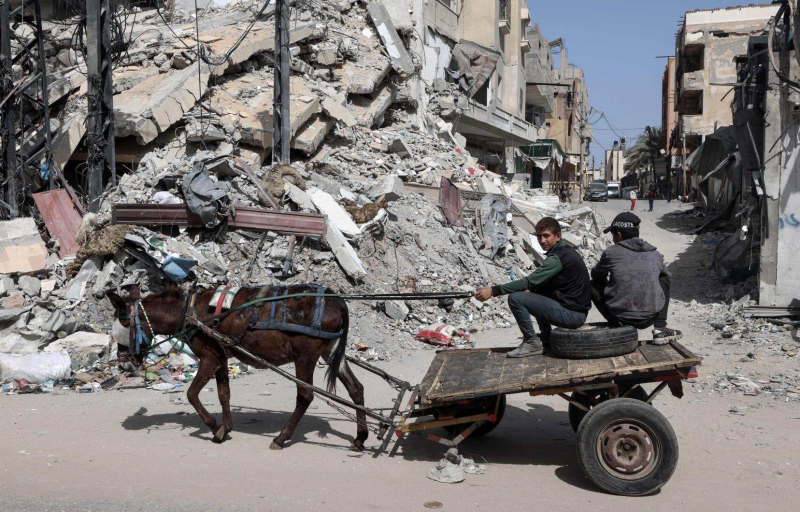
Photo: Mohammed Abed Agence France-Presse The war has caused a humanitarian catastrophe throughout the Gaza Strip where the majority of the 2.4 million inhabitants have been displaced and are now threatened with famine according to the UN.
Adel Zaanoun – Agence France-Presse and Benoît Finck – Agence France-Presse respectively in the Gaza Strip and Jerusalem
March 31, 2024
- Middle East
Dozens of deadly Israeli strikes fell Sunday on the besieged Gaza Strip threatened by famine at a time when a new round of negotiations for a truce between Israel and Hamas is due to begin.
At least 77 Palestinians were killed Saturday night in these raids, bringing the death toll in Gaza since the war began on October 7 to 32,782, according to the ruling Hamas Health Ministry. in the Palestinian territory since 2007.
Despite a UN Security Council resolution demanding an immediate ceasefire, fighting has not stopped in Gaza, almost six months after the start of the war, triggered by an unprecedented attack by the Palestinian Islamist movement Hamas on Israel.
In addition to the human toll and destruction, the war has caused a humanitarian catastrophe throughout the Gaza Strip where the majority of the 2.4 million inhabitants have been displaced and are now threatened with famine according to the UN, which has been deploring for weeks aid that is largely insufficient to meet the needs of the population.
On Saturday, a flotilla left Cyprus towards Gaza to deliver 400 tonnes of humanitarian aid thanks to the opening of a maritime corridor between Cyprus and Gaza.
A sign of a desperate situation, a food distribution in the city of Gaza (north) where aid is arriving with great difficulty, caused chaos during which five Palestinians were killed by gunfire and a stampede, according to a member of the Palestinian Red Crescent. The Israeli army told AFP that it had no information about this incident.
Several aid distributions in this city have turned tragic since February with more than a hundred deaths in total. Earlier this week, 18 Palestinians died, including twelve drowned at sea, while trying to recover food parachuted from planes.
“Getting out of indifference”
The war was sparked on October 7 when Hamas commandos infiltrated from Gaza carried out an attack in southern Israel that resulted in the deaths of at least 1,160 people, mostly civilians, according to an AFP count established from official Israeli data.
In retaliation, Israel vowed to destroy Hamas, which it considers a terrorist organization along with the United States and the European Union, and launched an offensive in the Gaza Strip where 1, 5 million inhabitants took refuge in the south, on the closed Egyptian border.
Faced with international pressure – including that of its American ally – as well as that of the hostage families, Israeli Prime Minister Benjamin Netanyahu announced on Friday that he had “approved a next round of negotiations, in the days to come, in Doha and Cairo […] to move forward.”
According to a pro-government Egyptian newspaper close to the security services, these negotiations are to resume on Sunday.
At the same time, anti-government demonstrators and families of hostages plan to meet on Sunday evening, and every evening until Wednesday, in front of the Knesset, the Israeli Parliament in Jerusalem.< /p>
The day before, thousands of people gathered in Tel Aviv to demand the release of the hostages.
“The time has come to come out and fight against indifference and for life. I ask you now to take to the streets with us and raise a united, clear voice: Bring them home now! said Saturday Shira Elbag, whose 19-year-old daughter Liri was kidnapped on October 7.
On Sunday, Pope Francis again called for a ceasefire and the release of the hostages in his traditional Easter message.
In recent months, several negotiation sessions have taken place via international mediators — Egypt, Qatar, United States — but without result, the two parties accusing each other of blockage.
Fighting around hospitals
Since the start of the war, only one week-long truce has been established at the end of November. It allowed the release of around a hundred hostages kidnapped during the October 7 attack in exchange for Palestinian prisoners incarcerated by Israel.
In the meantime, the Israeli army continues its offensive in the Gaza Strip and more particularly around hospitals, most of which are out of service, Israel accusing Hamas fighters of hiding there.
The army announced on Saturday that it had killed several fighters, including a leader of the Palestinian movement, in the al-Chifa hospital complex in Gaza City, the largest in the Palestinian territory.
According to Hamas, 107 patients are still “detained” in al-Shifa where the army is located for the 14th consecutive day. According to the World Health Organization (WHO), 100 patients and 50 healthcare workers are still in the complex.
On Sunday, the army announced that it had discovered “numerous weapons hidden in pillows, beds” and even the ceilings of the hospital complex.
According to Hamas, Israeli troops are also present in the Nasser hospital complex in the south of the Gaza Strip. The Palestinian Red Crescent reports that operations are also underway at al Amal hospital, also in the south.
According to the director of Kamal Adwan Hospital in northern Gaza, this facility is “the only one available for critical cases”, but is currently facing a blood shortage.

